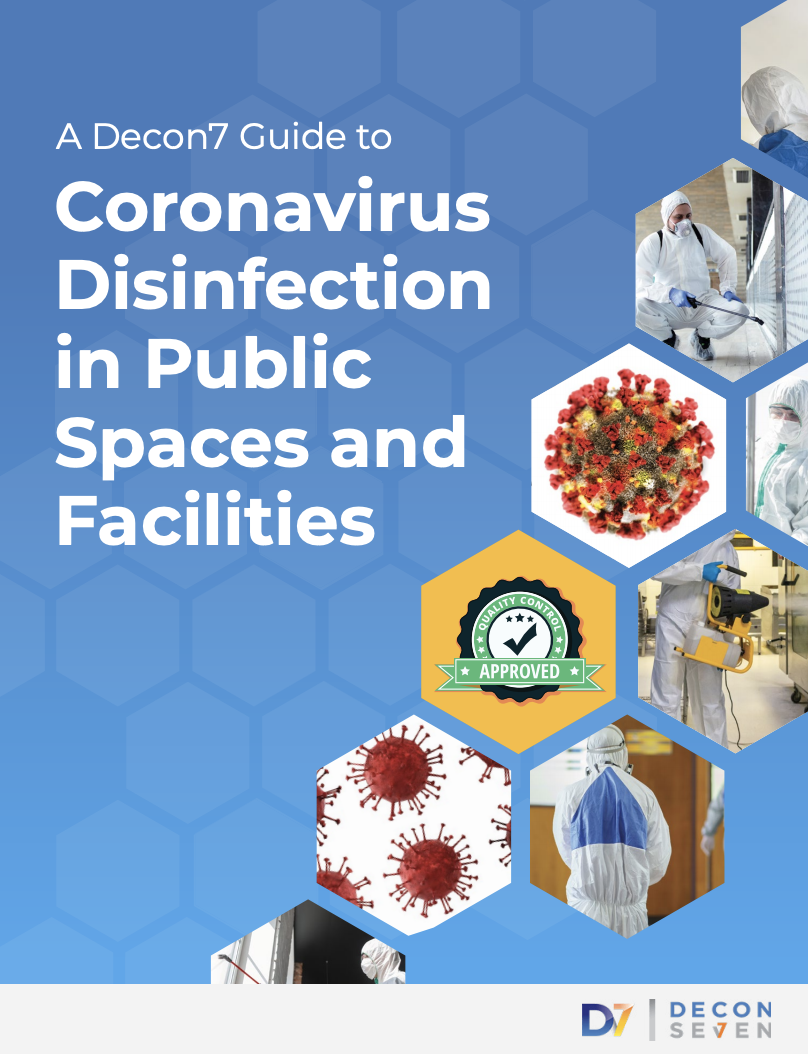Refer to CDC guidelines as you develop your plan because it may evolve as new information arises.
Determine what should be cleaned and disinfected
Make a list of frequently touched objects and surfaces that should be cleaned, then disinfected. Surfaces and objects that are not frequently touched should only be cleaned, and disinfectants should not be applied on items that children use. For outdoor areas, follow normal cleaning procedures, and only disinfect surfaces and objects that are frequently touched by multiple people.
D7 in Action
In response to the growing number of COVID-19 cases in China, Decon7 stepped up production of D7 disinfectant. We added seven new production facilities and ran double shifts in order to meet demand. We changed our shipping method from sea freight to air freight to get the product there in days instead of weeks. We were also able to change our packaging to match the use case. In the past, D7 had been shipped to China in large drums for use in agricultural applications. When shipping to China this year, we packaged D7 in smaller containers so it was ready to apply in healthcare facilities as soon as it arrived.
Make a list of frequently touched objects and surfaces that should be cleaned, then disinfected.
If a space has been unoccupied for more than seven days, follow normal cleaning procedures prior to reopening. Additional disinfection is not necessary. If a space has been unoccupied for more than seven days, follow water safety guidelines before reopening.
After cleaning and disinfection, disinfectants only need to be used again after a contagion has been reintroduced. If a space has remained unoccupied after it has been disinfected, surfaces do not need to be disinfected again unless they have been touched or breathed on by others.
Identify resources and equipment needed
Use an approved disinfectant for the particular threat. The EPA has compiled a list of disinfectants that are approved for use against SARS-CoV-2. However, although all of these products are effective, not all disinfectants are equal for the job. Some disinfectants are more effective than others. Look for the log kill—the number that tells you the percentage of pathogens it will kill—and choose a product with the highest number.
Some products are also more toxic than others, so do a little research and look for a disinfectant that has low toxicity and requires little or no personal protective equipment (PPE) to apply. It’s also important to choose products that are appropriate for the types of surfaces and materials you are treating. Not all disinfectant products are applied in the same way.
Some disinfectants need to be diluted or mixed, introducing the possibility for human error. Others need professional or specialized equipment to do the application, so make sure you understand what is required before making a purchase.
Make sure you have enough trained staff available to perform the cleaning and disinfecting work at the appropriate times. If any PPE is required for application, ensure that you have enough resources on hand to keep people safe.
Make cleaning and disinfection schedules and procedures
Clean surfaces and objects with soap and water, especially those that are visibly soiled. When disinfecting, follow label instructions for application procedures, recommended contact times, and necessary PPE.
For spaces that are consistently occupied with the same people, such as offices and childcare facilities, disinfection schedules may be performed less often, but frequently touched objects and surfaces should be disinfected at least once per day. For spaces with high turnover rates, frequently touched objects and surfaces should be disinfected on a more regular basis—in some cases, between each use.
Calculate the quantity and cost of resources
Keep enough cleaning and disinfecting products on hand to ensure you have enough to cover the areas you are treating, but don’t purchase an excessive amount so that supplies are depleted for others. Regularly check supply levels, and order new products before they are used up. Order with enough lead time to accommodate potential delays in deliveries and restocking. Adjust your maintenance budget to include sufficient funds for cleaning supplies, disinfection products, PPE, and laundering.
Provide education and training
Educate maintenance staff on the new procedures, and train them how to use any new products or PPE that are introduced. Teach employees how to participate in cleaning and disinfection procedures as needed. Post signs about proper hygiene, including hand-washing and coughing/sneezing protocols, and share information at team meetings to keep it top of mind.
Create a schedule and timeline
The level of urgency will depend on how the spaces are being used, whether they have been unoccupied or in use, how many people flow through the space, and other factors. When reopening a facility that has been closed for less than seven days, deep cleaning and disinfection should be done before occupants return. If the building has been unoccupied for more than seven days, routine cleaning is sufficient.
Create a schedule that includes who is responsible for cleaning and disinfection and how often it must be done. Include checklists for the items and surfaces that must be disinfected after each use, hourly, daily, and weekly. Create a reporting mechanism so you know that the procedures have been completed.







